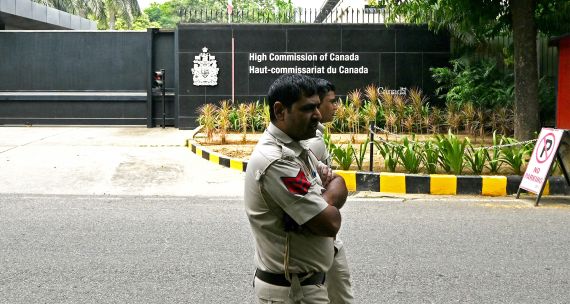As members of APF Canada’s Young Professionals Fellowship program, we welcome the release of the Government of Canada’s Indo-Pacific Strategy (IPS) as an exciting and long-awaited foreign policy development. We are encouraged by the serious and lasting commitment Ottawa is bringing to this vital and dynamic region, which will undoubtedly feature in the lives, work, and prosperity of Canadians in the years ahead.
However, we also recognize that it is still early days in the IPS’s development and implementation. As part of the generation that will inherit the results of this strategy, we offer some observations, and do so in the spirit of positioning Canada favourably for a productive and robust Canada-Asia relationship. These observations focus on priorities, gaps, and outstanding questions that we feel merit further discussion.
* In the interest of transparency, it should be noted that among the initiatives announced for funding under the Indo-Pacific Strategy, APF Canada is to be provided with C$24.5 million to support the establishment of a physical presence and new engagement programs in the region.
Show That Canada is Committed

Canada’s new Indo-Pacific Strategy is an ambitious one that shows that Canada understands the importance of the region and its increasing influence. At its core is a list of strategic objectives and initiatives that will allow Canada to achieve five priorities that range from increasing connections among people to laying the foundation for a greener future. But how will Canada achieve these goals?
Most of the Strategy’s goals will require increased engagement through leadership and collaboration with partners. What would this leadership look like, especially as Canada must re-engage in forums and regions where it has not been active recently?
One way that Canada could bolster its leadership in the region would be to help create a space for collective action. Collective action, in the context of international engagement, typically includes three factors: forging agreement on goals and their direction, coordinating actions to achieve the goals, and a commitment to continue to pursue the goals, even in the face of challenges.
I would argue that in the Strategy, Canada has already established, at a very high level, agreement on goals and actions. For example, increasing supply chain resiliency and providing humanitarian assistance are goals shared by multiple countries in the region, and the Strategy specifies the actions that will help achieve them. The tricky part will be the third factor: commitment.
The world is experiencing a particularly challenging period, with multiple events like an ongoing global pandemic, a land war in Europe with far-reaching implications, and threats to democracy on multiple fronts, all competing for attention in the foreign policy priorities of countries. Balancing these existing challenges with new objectives would prove a test for any country. That is not to say that Canada will not be able to increase its leadership in the Indo-Pacific. This renewed commitment demonstrates that Canada’s ambition goes beyond a strategy and indicates that there will be a renewed focus on the region that will last beyond the next few years.
Kelly Grounds is a Junior Policy Analyst at Innovation, Science, and Economic Development Canada. The opinions expressed in this article are her own and do not reflect those of her employer.
Consider More Trade with Taiwan

For an island with a mere 0.6% of the Indo-Pacific’s population, Taiwan has recently garnered a disproportionately large amount of attention in Canada. This largely reflects Canadians’ general concerns about China, described in Canada’s Indo-Pacific Strategy (IPS) as an “increasingly disruptive global power,” and the threat China poses to Taiwan’s democratic autonomy and way of life – two factors that resonate with Canadians.
The IPS acknowledges these concerns, stating that Canada will both “oppose unilateral actions that threaten the status quo in the Taiwan Strait” and “work with partners to push back against any unilateral actions in the Taiwan Strait.”
Such statements can be connected to the IPS’s general security commitments in the region. These include augmenting Canada’s naval presence, continuing Canadian involvement in nearby theatres (which will likely involve naval transit of the Taiwan Strait), and expanding military training programs and interoperability with nearby countries. Though the IPS does not explicitly connect these initiatives to Taiwan, and forgoes more provocative announcements relating to Taiwan’s defence or security groupings like the Quad and AUKUS, the strategy reflects Ottawa’s positioning – albeit indirect and limited – for deterrence in the Taiwan Strait.
At the same time, the IPS holds back when it comes to engagement with Taiwan. Though referenced 10 times, Taiwan is not listed as one of the strategy’s 31 priority economies and there are few new details on how Canada intends to respond to Taiwan’s calls for greater support. Canada and Taiwan have already held exploratory talks on a foreign-investment protection agreement, which some suggest could be negotiated within 48 hours. Yet, no mention of this is made. Neither talks on a bilateral trade agreement with Taiwan, which Ottawa indicated it is considering a day after the Strategy’s release, nor preliminary support for Taiwan’s bid to join the Comprehensive and Progressive Agreement for Trans-Pacific Partnership, are mentioned. In addition, there are no significant new initiatives to help the island develop its strategic resilience, despite references to continuing existing engagement. This silence overlooks the significant psychological component to Taiwan’s predicament, which clear but careful announcements of new initiatives could have addressed.
In some ways, this choice is unsurprising. Any statements on Taiwan, with which Canada has no formal diplomatic relations under its One-China Policy, are made in the shadow of Canada’s relationship with China. What is surprising, however, is that this dynamic has produced a strategy that leans more towards an implicit flexing of Canada’s underdeveloped military muscles rather than Canada’s more conciliatory strengths in economic engagement and diplomacy.
Ottawa may announce trade talks with Taipei tomorrow, but until then, we are left with a position that seems out of sync with Canada’s strengths.
D’Arcy White is a Toronto-based lawyer. The opinions expressed in this article are his own.
Take India's Rise Seriously

The new Indo-Pacific Strategy (IPS) contains many promising initiatives. Canada has long needed a coherent, long-term plan with respect to the Indo-Pacific region, and the Strategy is a good step in that direction. Investments in knowledge-building capacity for Canadian scholars, policymakers, and businesspeople to increase their understanding of the region stands out as a strong and timely component.
However, the treatment of India in the Strategy lacks a long-term strategic view of the future role of this country, both within the region and in the wider world. The Strategy devotes an entire section to India, indicating that the Canadian government rightly views it as an important factor in its regional engagement. Discussion of India in the text of the IPS focuses on economic engagement, market access, immigration, and academic/cultural exchanges. While this makes sense given the current economic and development conditions in both countries, the Strategy does not take into account India’s rise as one of the world’s major powers. While the Strategy does seem to recognize the growth potential of India’s economy, it does not fully reflect the extent to which economic growth can be converted into geopolitical heft.
Interestingly, the IPS's tone toward India is reminiscent of the Canadian government's tone toward China two decades ago. Recall then Prime Minister Paul Martin’s address to the Canada-China Business Council in 2005, where he said that “we seek to enhance our engagement with China -- to foster a real partnership that comprises not just economic pursuits, but also the global political agenda: public health, environmental issues, human rights, and culture.” What was missing about the analysis of China then – and India now – is the recognition that as countries grow economically, so too does their ability to shape the international system. Under current growth trends, India is projected to be the world’s third-largest economy by 2030, with a purchasing-power-parity-adjusted GDP of US$19.5 trillion. With such economic clout, India will be able to leverage its prominent role in the global economy to convince other nations to accede to its demands to adjust international rules to be more compatible with its own national interests.
Interestingly, Martin did say in 2005 that “China will be central to the success of a New Multilateralism, and that is why we are dedicated to building a mutually beneficial relationship – a partnership that recognizes the changes that are occurring in how the world interacts, and also in how economic activity is undertaken." Therefore, Martin may have been aware to some extent that China’s economic growth would have large implications for the international order, but the government was not fully appreciative of the significance of this statement. Canada should not make the same mistake regarding India.
To prepare for the day when India will want to be a shaper rather than a taker of international rules, the government should place greater emphasis on promoting an understanding of India among Canadian scholars, policymakers, and Canadian people at large. The current Strategy mostly emphasizes building knowledge about China, but the same should be done for India. In particular, an understanding of Indian history from India’s perspective, and how the people of India see their place in the world, will be key to preparing for the country’s geopolitical rise.
Peter Wu is a M.A. student in economics at the University of Toronto. The views expressed in this article are his own.
Dust Off Old Track II Playbook for Engaging ASEAN

With Canada’s Indo-Pacific Strategy (IPS), the federal government has outlined its overarching policy for a renewed focus on the region. Importantly, enhancing Canada’s relationship with the 10-member Association of Southeast Asian Nations (ASEAN) as a priority is more than just lip service — more than C$37 million is pledged in the next five years for the ASEAN-Canada Plan of Action Trust Fund and the Canadian Trade Gateway alone, while other funds have been dedicated to expanding Canada’s ASEAN scholarship program and expanding our physical presence in the region.
With this new funding, Canada has a generational opportunity to make an impactful return to the region. As we now move to implementation, my three recommendations are for Canada to 1) identify the niche that it can fill within ASEAN; 2) remove unnecessary barriers for deeper integration with the region; and, 3) ensure that funding reaches the most vulnerable populations in ASEAN.
On the first point, Canada can reclaim the role it once held as a facilitator of Track II (non-governmental) dialogues – avenues for promoting open communication on sensitive regional issues, such as the U.S.-China rivalry over Taiwan or the crisis in Myanmar, and to help build guardrails against the escalation of conflict. I have spoken with Southeast Asian academics who recall Canadian middle power diplomacy during the 1990s as the most significant period of Canadian leadership on issues of importance to ASEAN. Canada’s early embrace of Track II diplomacy channels like the Council for Security Cooperation in the Asia Pacific, its facilitation of maritime dialogues in the South China Sea, and its involvement in confidence-building measures for regional security, all boosted Canada’s value as a strategic partner. But Canada has since taken a backseat in such dialogues and must now re-establish itself within these networks.
On the second point, Canada will need to assess its own domestic policies. For example, citizens from eight of the 10 ASEAN member states require visas to enter Canada and face an onerous and costly process to do so. A practical step towards achieving the IPS’s third strategic objective – investing in and connecting people – could be to evaluate whether the expansion of the simplified electronic travel authorization (eTA) program (with some exceptions) is feasible, in an effort to remove barriers for ASEAN visitors.
And on the third point, Canada must ensure that its initiatives are diversified across the ASEAN region, particularly in economies that face threats to human security, whether through economic challenges, political upheaval, or as a result of climate change. The funds set aside for mine-clearing projects in Cambodia and Laos is an excellent initiative in this regard.
Lauren Shykora is a Master of International Affairs candidate at the National University of Singapore. The opinions expressed in this article are her own.
Think Bolder on Canada-India Relations

India’s place in Asia is rapidly becoming prominent – any country charting its Asia strategy will have to place special focus on the largest democracy, and soon to be third-largest economy in the world. Canada is attuned to this reality, reflected even in the title of its recently released Indo-Pacific Strategy (IPS). The focus stops there, however. The IPS fall short in signaling the depth of the relationship Canada seeks with India as a counterbalancing power in the region, as Canada seeks to rethink its relationship with China and diversify its interests and involvement in the region, particularly in South and Southeast Asia, from which it has been missing. This is reflected in the superficial measures outlined in the IPS that attempt to strengthen the trade, immigration, and diasporic ties, without a consideration of two key priorities – co-operation on security and natural resource development.
Canada appears to weakly double-down on existing economic and immigration linkages to India. The IPS would have been better served if it focused on a few areas of strategic interest in the region, particularly in natural resource development. As the world transitions to a low-carbon economic future, Canada will play a bigger role in providing the critical minerals that will feed the electric transportation supply chain. Aligning Canada’s recent critical minerals strategy with the IPS was a missed opportunity, particularly as India is itself transitioning, with mixed degrees of success, to a low-carbon economy. As Canada is also considering options to decarbonize its own electricity grid, it could take the opportunity to share knowledge and create capacity-development networks with India as it attempts to wean itself off coal as the primary source of electricity generation.
As Canada attempts to refocus its efforts and diversify its ties in Asia, the IPS reflects the tension and continued challenges Canada faces in foreign policy strategy. Although Canada is party to agreements and international fora in areas as diverse as trade, climate action, and intelligence, it is often not at the head of table, and foreign policy here is often shaped by events elsewhere. The shortcomings of Canada’s attempts to focus on its relationship with India in the IPS may be a cautionary tale – that it should not spread itself too thin and risk being viewed as a superficial partner, but rather to double-down on its areas of expertise and create dialogue to openly share how the country is working to achieve its ambitious economic, trade, social, and climate agendas. If it does so, it may emerge out of its middle-power status to become more of a shaper, rather than a taker, in the realm of foreign policy.
Varun Srivatsan is an Advisor at the Department of Natural Resources. The opinions expressed in this article are his own and do not reflect the views of the Government of Canada.
Get More Specific on Women, Peace, and Security Agenda

Established by United Nations Security Council Resolution 1325 in 2000, the global Women, Peace and Security (WPS) agenda intends to raise awareness of the unequal effects of conflict on women and girls and increase the meaningful participation of women in peacebuilding, peacekeeping, and conflict prevention. Including the WPS agenda in Canada’s Indo-Pacific Strategy is both notable and meaningful; however, Canada’s approach, as described in the Strategy, remains vague and lacks detail on how Canada will support the integration and expansion of the WPS agenda in the Indo-Pacific.
For example, under its first strategic objective, the Strategy envisions expanding on training programs and military capacity-building initiatives to enhance regional partnerships, “including in the area of Women, Peace and Security.” Since its induction, the WPS agenda has been interpreted and implemented in myriad ways. This variance is prominent in the Indo-Pacific, where the diversity of military and security operations and priorities is expansive.
The same is true of the active regional organizations, including the Association of Southeast Asian Nations (ASEAN). Individual ASEAN member states and ASEAN as a regional organization have different ideas of how WPS should be implemented and what their goals in this regard are. For example, while both the Philippines and Indonesia have had multiple National Action Plans on WPS, they differ in their approaches. The Philippines invites civil society organizations to participate throughout the consultation process and emphasizes women’s role and agency in WPS. Alternatively, Indonesia uses a mostly top-down approach, and portrays women as victims rather than recognizing their agency. Furthermore, there is no mention in the Strategy of ASEAN’s Regional Action Plan on Women, Peace and Security, a prominent report that promises to direct work in this area in ASEAN and with their varied strategic partners, including Canada.
As Dr. Stéphanie Martel discussed in an earlier APF Canada publication, “the Strategy does best when it outlines specific, targeted, and creative co-operative initiatives that speak to its key objectives and the broader principles underpinning Canada’s foreign policy, while also catering to regional demand.” Regional considerations – not simply Canada’s ideas of WPS priority areas – must be included in the strategic objectives.
While it is to be expected that a strategy that covers so many issues might be lacking in detail on any one of them, at least initially, activating Canada’s Indo-Pacific Strategy must be responsive to national action plans, regional action plans, and other regional initiatives. To be effective, consideration of local context, varying regional interpretations of the WPS agenda, and integration with pre-existing activities must be detailed further.
Emma Fingler is a doctoral candidate in the Department of Political Studies at Queen’s University. The opinions expressed in this article are her own.
Recognize Regional Differences in Supporting Women-owned Businesses

Canada’s Indo-Pacific Strategy strengthens Canada’s position as a reliable economic partner in the Indo-Pacific. It does this by promoting rules-based trade through an emphasis on longstanding relationships in the North Pacific (e.g., with Japan and South Korea) and developing strategic partnerships in the region to align with Canada’s priorities in national security and supply chain resilience.
However, the breadth of the Strategy’s focus raises the risk that we may be unable to deliver in two critical areas. First, there is a lack of an integrative approach across the Strategy’s five objectives in regards to the Feminist International Assistance Policy. Second, the Strategy lacks clear targets to enhance inclusive economic growth in the region for micro, small, and medium enterprises (MSMEs) in the 10 member states that comprise the Association for Southeast Asian Nations (ASEAN) – a sub-region identified as a priority in the Strategy.
The Feminist International Assistance Policy (Policy) in the ASEAN-Canada Plan of Action Trust Fund is mentioned in the Strategy’s third objective of promoting people-to-people connections. Since diversification is a key priority for Canada, there is an opportunity to integrate the Policy across all five of the Strategy’s objectives. In particular, the Strategy’s second objective – expanding trade, investment, and supply chain resilience – could be more explicit in how the Women’s Entrepreneurship Strategy (WES) will be implemented to support women entrepreneurs by setting targets for priorities that are common to both the Policy and WES, including improved access by women to trade finance under Canada’s Official Development Assistance Accountability Act.
MSMEs are a vital part of ASEAN economies, accounting for approximately 98 per cent of the region’s economy activity; however, the Strategy is not explicit in how it will promote or partner with MSMEs to expand trade and supply chain resiliency in the region. The Strategy allows Canada to align ASEAN priorities on MSMEs promotion with its own priority to expand Canadian MSMEs in ASEAN through aligning values in the CanExport program.
The Strategy does provide a clear overall direction on Canada’s engagement in the region and priorities for diversification. A key consideration should be avoiding taking a blanket approach when working with ASEAN member states in promoting the companion Policy. The Strategy has outlined key indicators for engagement with countries including India, Indonesia, and in the North Pacific; however, key indicators for engagement with each ASEAN member state are essential to carry out a sustainable strategy in that sub-region.
Shaivalini Shukla is a Master of Public Policy candidate at the Munk School of Global Affairs and Public Policy at University of Toronto. The opinions expressed in this article are her own.
Avoid Overstretch and Invest Our Resources Wisely

The Government of Canada’s long-awaited Indo-Pacific Strategy is a useful direction-setter in guiding Canada through a complex foreign policy landscape in the world’s fastest-growing region. Calling for a “whole-of-society” response, the Strategy covers a wide range of partnerships, programs, and investments that intend to seize the opportunities of a “once-in-a-generation” regional dynamic. Canada’s engagement in the Indo-Pacific, a region of unequivocal importance, will have real impacts on our citizens – from economic growth to democratic values and national security.
Although the Strategy signals that billions will be made in investments in support of its objectives, Canada should remain prudent regarding the diplomatic, security, and humanitarian outcomes of these proposed engagements. Our commitments are plentiful, spanning the areas of feminist international assistance programming, security-based naval engagement, and new joint training programs with ASEAN partners to enhance interoperability. Woven throughout these commitments is a notable focus on women and girls, whether in the promotion of peace and security or as agents of democracy and prosperity through a development lens. Moreover, in a time of democratic backsliding, our commitments to humanitarian assistance, transitional justice, and equitable governance are all deeply needed.
But Canada has to make choices. Our various defence, development, and democratic commitments can be implemented not as wholly separate initiatives but rather in tandem. These commitments should target the areas where the impact is most likely to endure and materialize substantive benefits to our partners and allies. The longstanding work of the Anti-Crime and Counter-Terror Capacity Building Programs in Southeast Asia that contribute to women in peace and security is an example of this. Valuable counter-terrorism capacity building for law enforcement across ASEAN has benefitted from Canada’s continued engagement, such as the CT-ASEAN programme, which has trained more than 550 officers across 10 countries, promoting border security and regional stability.
In addition, the Strategy’s characterization of China’s “disruptive” global power, especially in the South China Sea, is consequential and it alludes to the security role that Canada should play in the region. If Canada is to enhance its security contribution, it must expand upon existing military capacity and strike a balance between domestic capacity building and investments in the capacity of its partners. The risk of overstretch for our military or development commitments, and the subsequent detriment to Canada’s reputation as a formidable partner to ASEAN, should not be ignored.
To maximize the success of Canada’s material commitments in the Indo-Pacific Strategy, committing to less is sometimes doing more.
Leo Xu is a Consultant at Deloitte Canada’s Public Sector Transformation practice. The opinions expressed in this article are his own.
Make Education Initiatives More Equitable

As the future inheritors of Canada’s Indo-Pacific Strategy (IPS), it is encouraging to see references to youth and education within this plan. With an aging population leading to a shrinking workforce, Canada needs to make long-term investments in attracting bright and diverse talent to our country. Through the IPS, Canada has committed to “expanded education exchanges and bolstered visa-processing capacity” in the Indo-Pacific, funding 1,000 scholarships and fellowships, and strengthening support for international students looking to obtain permanent residency and employment in Canada.
At a high level, it is good to see these commitments. For these commitments to have a whole-of-society impact, however, will require the involvement of not just Canada’s “elite,” research-intensive universities but also those that provide increasingly vital vocational education.
For example, the Canada-ASEAN Scholarships and Educational Exchanges for Development (SEEDS) Program, announced in 2017, provides significant funding for students from the member states of the Association of Southeast Asian Nations (ASEAN) to conduct study or research in Canada that focuses on the UN’s 2030 Agenda for Sustainable Development. However, participation in the program is limited to Canadian post-secondary institutions that have an existing exchange agreement with an ASEAN country. This leaves out polytechnics and colleges like BCIT and Humber College, which comprise a vital part of Canada’s higher education sector but have much more limited, if any, standing exchange agreements in Southeast Asia. Similarly, the Canada Learning Initiative in China (CLIC), which provides generous funding for Canadian students to study in China, is only open to students from Canada’s top research-focused institutions.
Canadian colleges and polytechnics may also not have the research funding or resources in general to take advantage of opportunities outlined in the IPS that are available to other higher education institutions. As such, intentional efforts must be made to provide these institutions with financial, logistical, and relational support, especially those schools that show initiative to engage more deeply with Indo-Pacific partners. Two promising examples include Saskatchewan Polytechnic (an institution focused on technical training) opening a new office and signing an MOU with Central Philippine University in the Philippines to “explore international education and collaboration opportunities between the two institutions,” and Concordia University, a middle-of-the-pack Canadian institution in Montreal, opening a Canada-ASEAN Business Council office on its campus.
Beyond the desire of both these institutions to recruit more international students from Southeast Asia, both press releases highlight the opportunity for additional areas of collaboration, such as joint research projects and curriculum development. More assistance should come from all levels of government in Canada to encourage these partnerships and connections, creating a more comprehensive and long-lasting impact for the future inheritors of the IPS.
Ian Stone is an analyst within Deloitte’s Higher Education Transformation practice. The views expressed in this article are his own.
Use the Opportunity to Address Anti-Asian Racism


Asian diaspora groups in Canada are identified as important bridge-builders in Canada’s Indo-Pacific Strategy (IPS), specifically, its third pillar of investing in and connecting people. The IPS highlights the Government of Canada’s Anti-Racism Strategy 2019-2022 (ARS) as a key policy in its engagement with Asian-Canadians, noting the need to both “foster greater inclusion of diaspora communities” with ties to the Indo-Pacific region and fight anti-Asian racism in Canada. However, neither strategy specifically addresses anti-Asian racism, especially in light of the COVID-19 pandemic and further geopolitical confrontation between Canada and China. It also remains unclear how the federal government plans to invest in Canada’s diasporic communities in the context of the IPS’s third pillar.
This gap in domestic policy could be filled by a revised ARS, particularly as Asian-Canadian groups have experienced a spike in anti-Asian crimes linked to the COVID-19 pandemic. There are also fears of further racist backlash as a result of growing anti-China sentiment, which may worsen as the Government of Canada takes a tougher stance on China. Ottawa needs to acknowledge the racial grievances and internalized racism that the current geopolitical climate and pandemic have surfaced. Otherwise, Canada risks further alienating Asian diaspora communities.
Some Canadian scholars have hotly debated what exactly the term ‘Indo-Pacific’ might come to indicate. One professor has argued that it could be a “containment of China framing.” Others have argued that it means aligning partners within the Asia Pacific region to “maintain U.S. dominance.” But for Canada's Asian diaspora groups, it invokes a feeling of discomfort, having a new label – “communities of Indo-Pacific heritage” – imposed on them through a new geopolitical construct. A revisited ARS should outline a clear and informed strategy to engage Asian-Canadian communities in a way that not only meaningfully advances the language of “multiculturalism” but also supports the diaspora’s conceptualizations of self-identification and feelings of belonging in Canada.
The Government of Canada committed C$45 million over the 2019-2022 period to implement the ARS, of which C$30 million went towards community-based projects, and C$4.5 million was allocated to the Anti-Racism Secretariat. Given that Canada’s IPS was released a month before the ARS’s conclusion, the government has the opportunity, through a successor to its anti-racism policy, to re-commit and increase investments in Asian-Canadian community projects and the Federal Anti-Racism Secretariat.
Amid the pandemic, many Asian-Canadian community organizers have criticized the ARS for failing to address anti-Asian racism specifically. Many of these community groups, including the Chinese Canadian National Council Toronto Chapter and Project 1907, have been at the forefront of identifying and fighting anti-Asian racism. A revision of the ARS must explicitly tackle anti-Asian racism by ensuring sustained and increased funding for Asian-Canadian community projects and enhancing the capacity of the Anti-Racism Secretariat to support them. Doing so could be the keystone for the IPS’s engagement with the Asian-Canadian diaspora.
Patrick Leong is a Policy Analyst at Environment and Climate Change Canada. Jacklyn Yee is a Trade Policy Analyst at Natural Resources Canada. The opinions expressed in this article are their own and do not reflect those of their employers.




